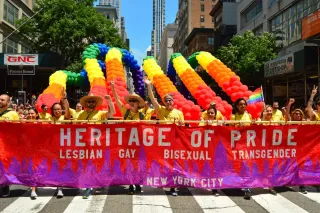March 31, 2020
Extroverts (and Introverts, Too) Face Quarantine Challenges
Deepti Hajela READ TIME: 4 MIN.
Within days, Vicktery Zimmerman had figured out how to connect with friends and family even as she and her husband shelter in place at their Chicago home.
There are the FaceTime calls. There's the movie night (remote, of course) with another couple. There are plans for a game night. Whatever it takes to keep the 30-year-old self-professed extreme extrovert and public relations specialist from, as she puts it, "spinning in circles."
Justin Zimmerman, 32, her introverted husband, is bemused – and amused – by it all.
"Now it's become a thing where people are FaceTiming us all day, every day to say 'Hi,' " the doctoral student said, laughing. "I'm like, 'You really don't have to.'"
The self-isolation designed to arrest the coronavirus' spread has turned the tables on many norms – like living life outside the four walls of home, gathering socially at the drop of a hat and having everyday social interactions with anyone from your local barista to the guy at the corner store.
But even in pre-virus times, there were people for whom those things were more pressure than pleasure: Introverts, those who largely get their energy from inside themselves and selected interactions with people, as opposed to extroverts, who obtain it from outside themselves.
The quarantines and distancing have upended that. It's a relief for some introverts who now don't need excuses for why they don't want to be out – and, equally, a struggle for extroverts seeking out social connection in a world where that's suddenly a limited commodity.
Eric Bellmore, an avowed extrovert, found himself yelling a greeting across the road to someone he didn't know when he went for a jog near his home. He just wanted a moment of interaction.
"It's mind-boggling to grasp how much I need to be around other folk," said Bellmore, 47, who works in IT in Mount Pleasant, Michigan.
"My wife actually said to me last week: `For someone like you, this must be hell.'"
It's been a relief for David Choi, a 34-year-old Los Angeles musician who is an avowed introvert even as the demands of professional musicianship required him to be networking and making the social rounds.
The demand to quarantine, he says, "gives you an excuse to stay home which is what you want to do in the first place."
The world generally has been a place where extroverts are rewarded and introverts get a side-eye, says Lisa Kaenzig, the highly extroverted dean of William Smith College. She has studied introverted learners for years.
But the quarantines have changed those assumptions, she says. While everyone shares in the anxiety and worry over the virus, the actual demand of staying home and limiting social interaction has felt like a boon to the introverts she's spoken to.
"All of the things that make the world harder for them as introverts, the world is better for them right now. They're adapting much more quickly," she says.
One introvert she spoke to was actually leery of the post-quarantine return to socializing, Kaenzig said, not looking forward to being swarmed by effusive extroverts looking for hugs of greeting.
For some introverts, though, there has been a struggle with the idea that staying home is a matter of government demand, that there's no option of going to a cafe or coffee shop if they did want some human interaction.
Jackie Aina would often do just that to break up the monotony of working from home, where the makeup artist and online content creator already spends most of her time.
"Being able to go to the local coffee shop, it's nice just to switch up the environment," says Aina, 32, of Los Angeles.
"Now that control is being taken away," she says. "That's very different than choosing when and how you get to stay at home."
And of course, for those extroverts and introverts who share homes where they are being told to self-isolate, it's created a new level of challenge: learning to live with each other.
Extroverts have found ways to do many things remotely – video conference calls for work and school or even lunch dates, regular check-ins with loved ones over phones or computers, sometimes to the bafflement of the introverts they live with.
Jackie Hardt, 34, of Buffalo, New York, recently used video conferencing to have a long coffee date with a colleague or a lunch date with friends. Her introverted husband, she says, doesn't understand that the least bit.
"It would be very hard for him to make virtual happy hour or virtual coffee," she said. "He'd be perfectly fine not seeing his friends until this is all over. For me, that would be a lot harder."
Through the recent days of unusually close quarters, they've been trying to respect each other's needs.
"I think he recognizes I might need more interaction during the day," she said. At the same time, she said, after several years of marriage, "I know when he needs to be quiet and be by himself. I'm trying to recognize that a little bit more."
In light of what the world is facing, she has an idea for a marriage vow that she believes would be more apt for the times: "In quarantine and social isolation is really what they should make you promise to each other."
___
Deepti Hajela covers issues of race, ethnicity and immigration for The Associated Press. Follow her on Twitter at http://twitter.com/dhajela






